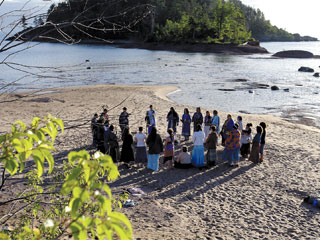By Greg Peterson, Today correspondent
Story Published: Jul 1, 2010

Photo by Greg Peterson
Ojibwa Sunrise Ceremony along Lake Superior at Little Presque Isle
Point to honor sacred Eagle Rock, the Yellow Dog Plains and Lake
Superior for National Sacred Places Prayer Days.
LITTLE PRESQUE ISLE POINT, Mich. – As if emerging from the icy depths
of Lake Superior, the fiery yellowish-orange sun rose the morning of
June 19 to greet American Indians and non-Natives praying during the
“Honoring Our Water” ceremony by Ojibwa women and gave them the strength
to continue battling an international mining company that is desecrating
sacred Eagle Rock on the nearby Yellow Dog Plains in Michigan’s Upper
Peninsula.
The sunrise service at Little Presque Isle Point in northern Marquette
County was one of many Native events across the country during 2010
National Sacred Places Prayer Days as the tribes try to protect their
threatened religious sites.
The ceremony happened only three weeks after the May 27 police raid on
the month-long encampment at the base of sacred Eagle Rock (Migi zii wa
sin) during which two Ojibwa were arrested for trespassing on orders
from officials with the Kennecott Eagle Minerals sulfide mine. Kennecott
bulldozers have cut a large swath across the Yellow Dog Plains and cut
down countless trees and destroyed vegetation including at the base of
sacred Eagle Rock, where the portal to the underground nickel and copper
mine is planned.
The Creator’s creation was abundant on the peaceful calm morning.
Ever-present flocks of seagulls mixed with cormorants darting on
thermals as a lone white-tail deer strolled up the sandy remote beach
within 30 yards of those preparing to begin the ceremony nestled between
flat shale ledges and outcroppings of granite boulders. Some believe
they felt the Creator’s presence during the last moments of the event on
an otherwise still morning when a single strong gust of wind blew
through the dunes and trees as 50 people were singing the “Chi Miigwech”
(many thanks) song thanking Gitche Manitou (Great Spirit).
They expressed thanks for sacred Eagle Rock, Lake Superior (Gitchi Gummi)
and its tributaries like the Salmon Trout River under which Kennecott
plans to extract rock from the six-acre, 1,000 foot deep “Eagle Deposit”
the company says will yield 16,000 tons of nickel and about 10,000 tons
of copper annually.
The ceremony was hosted by Stand for the Land and Oshkinawe-Ogichidaag
Akiing (New Warriors for the Earth), a new environmental organization
“grounded in Anishinaabe traditions with a mission to educate and
empower our communities to take action on mining and other
social-ecological issues facing our communities.”
Holding flowers and wearing traditional Native skirts and blue prayer
ties and blue shawls to honor the water, the women formed a circle on
the edge of Lake Superior.
They prayed for the “sacredness of the water and Mother Earth,” said
co-organizer Jessica Koski, a member of the Keweenaw Bay Indian
Community and master’s candidate of environmental management at Yale
University.
As the women prayed, the men held a drum on a cement slab circle about
50 yards away in the dunes.
Three generations of women participated in the ceremony that included
praying “to the Creator to heal the water and thank the water for being
here and everything that it gives us,”said ceremony leader Eagle Heart
Woman, who requested her spirit name be used instead of her English
name.
The women, who traveled from as far away as Wisconsin, brought jars
filled with water from many different lakes and streams including fresh
spring water from the aquifer underneath Eagle Rock.
“We are going to ask the Creator to bless not only the Lake Superior
water but the water that’s in the bowl,” said Eagle Heart Woman,
standing next to a sacred eagle staff planted firmly in the sand.
As the women’s ceremony ended, they spread out along the beach and waded
into the crystal clear waters to pray and “offered the flowers to the
water” by setting them afloat on Lake Superior.
The second to the last song played by the men’s drum was a Lakota deer
song to honor the white tail who visited the beach.
Eagle Rock is a “sacred place to Anishinaabe people,” said Koski, who
encourages all people to be “part of the movement to protect our sacred
places, water and way of life for future generations.”
After the Lake Superior event ended, many traveled nearly 80 miles to a
related community potluck picnic lunch and Sacred Places Prayer Days
gathering at the KBIC Powwow Grounds Pavilion in Baraga, Mich.
Organizers of the events in northern Michigan encourage women across
Indian country to make and wear blue shawls to show solidarity with
their cause to help protect the water from sulfide and uranium mining
across the Great Lakes Basin and from oil disasters like the ongoing
crisis in the Gulf of Mexico.
“The integrity of Eagle Rock is in jeopardy as Kennecott’s planned mine
portal, to be blasted into in order to access the nickel, copper and
other precious metals underneath the Salmon Trout River,” said Koski,
who traveled to London to condemn Rio Tinto – Kennecott’s parent company
– for putting one of the largest freshwater lakes in the world at risk.
“Unfortunately, the Michigan Department of Natural Resources and
Environment determined this place unworthy of protection as a place of
worship because it does not consist of any buildings or church-like
structures.”
© 1998 - 2010 Indian Country Today. All Rights Reserved To subscribe or visit go to: http://www.indiancountry.com